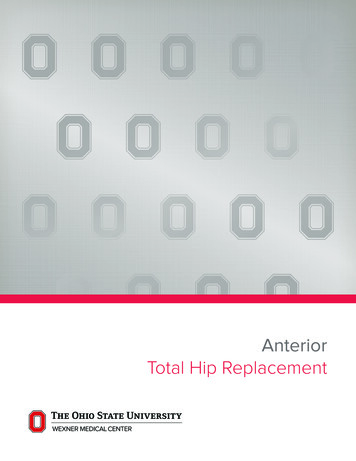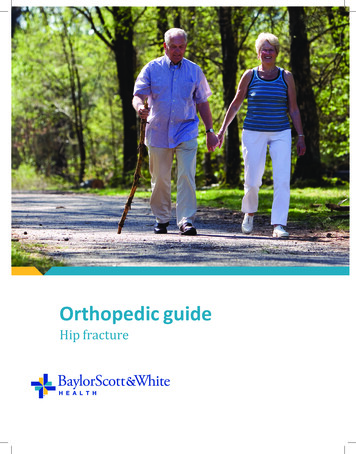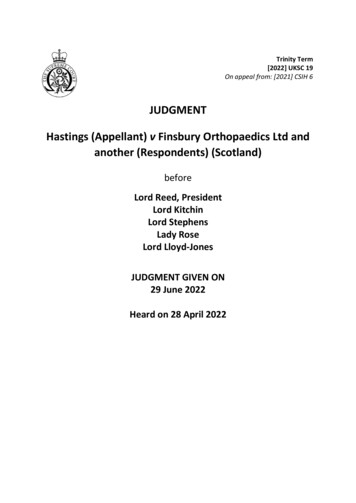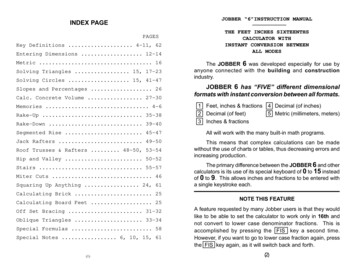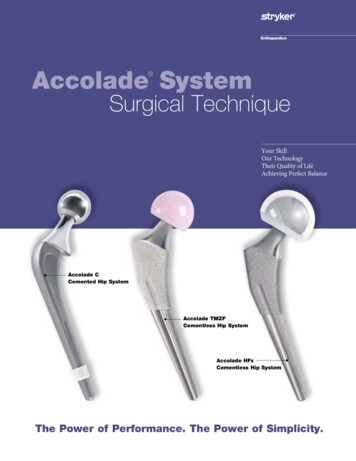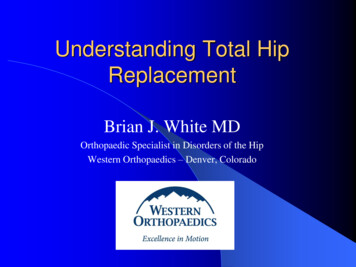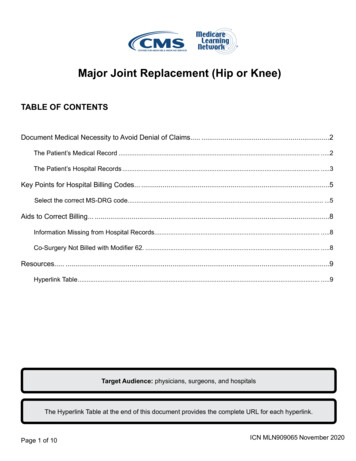
Transcription
Major Joint Replacement (Hip or Knee)TABLE OF CONTENTSDocument Medical Necessity to Avoid Denial of Claims. .2The Patient’s Medical Record . .2The Patient’s Hospital Records . .3Key Points for Hospital Billing Codes. .5Select the correct MS-DRG code. .5Aids to Correct Billing. .8Information Missing from Hospital Records. .8Co-Surgery Not Billed with Modifier 62. . .8Resources. .9Hyperlink Table . .9Target Audience: physicians, surgeons, and hospitalsThe Hyperlink Table at the end of this document provides the complete URL for each hyperlink.Page 1 of 10ICN MLN909065 November 2020
Major Joint Replacement (Hip or Knee)MLN BookletNote: We revised this product with the following content updates: Updated certain items to reflect current year (for example, we refer to ICD-10 codes for 2020,instead of 2017). Changed references to DRG to say MS-DRG Made minor clarifications that did not alter the substance Added a reference to the Beneficiary and Family Centered Quality Improvement Organization Changed a reference to an Intravenous Catheter to Inferior Vena Cava Changed references to Coumadin to WarfarinMajor joint replacement or reattachment is one of Medicare’s top volume Medicare Severity Diagnosis RelatedGroups (MS-DRGs). Due to the high volume of these claims, CMS has had multiple auditing entities, includingthe Recovery Auditors, Comprehensive Error Rate Testing (CERT) Contractors, the Beneficiary and FamilyCentered Quality Improvement Organization (BFC-QIO), and MACs review claims for these MS-DRGs.Their findings demonstrate very high paid claim error rates among both hospital and professional claims onmajor joint replacement surgery. For example, table D4 of the 2019 Medicare Fee-for Service SupplementalImproper Payment Data shows that the Major Hip And Knee Joint Replacement Or Reattachment Of LowerExtremity category represents the highest dollar amount for improper payments identified in 2019.DOCUMENT MEDICAL NECESSITY TO AVOID DENIAL OF CLAIMSCMS recognizes that joint replacement surgery is reserved for patients whose symptoms have notresponded to other treatments. To avoid denial of claims for major joint replacement surgery, the medicalrecords should contain enough detailed information to support the determination that major joint replacementsurgery was reasonable and necessary for the patient. Progress notes should consist of more than justconclusive statements. Therefore, the medical record of the joint replacement surgical patient mustspecifically document a complete description of the patient’s historical and clinical findings. Both physicians(includes physician treatment, evaluation and consultation records from the office to document medicalnecessity for surgery) and hospitals are responsible for ensuring a complete and accurate record.Note: While Total Knee Arthroplasty and Total Hip Arthroplasty have been removed from the InpatientOnly List, the documentation requirements are still valid.The Patient’s Medical RecordThe history should include information such as: A description of the pain (onset, duration, character, aggravating, and relieving factors) Limitation of specific Activities of Daily Living (ADLs) Safety issues (for example, falls) Contraindications to non-surgical treatmentsPage 2 of 10ICN MLN909065 November 2020
Major Joint Replacement (Hip or Knee)MLN Booklet A listing, description and outcomes of failed non-surgical treatments, such as:– Trial of medications (for example, Nonsteroidal anti-inflammatory drugs (NSAIDs))– Weight loss– Physical therapy– Occupational therapy– Intra-articular injections– Braces, orthotics or assistive devices– Physical Therapy and/or home exercise plans– Assistive devices (for example, cane, walker, braces (specify type of brace), and orthotics)The physical examination should describe the joint examination with detailed objective findings, such as: Any deformity Range of motion Crepitus Effusions Tenderness Gait description (with or without mobility aides)Investigations should include the results of applicable tests (for example, plain radiographs and pre-operativeimaging studies). Consultation records for any associated co-morbidities, for example, cardiology consult,diabetes management pre, intra, and post operatively.A statement of clinical judgment with reasons for deviating from a stepped-care approach may be included.The Patient’s Hospital RecordsThe pre-operative portion of the hospital record for the joint replacement surgical patient should includedocumentation of specific conditions, such as: Osteoarthritis (mild, moderate, severe) Inflammatory arthritis (for example, rheumatoid arthritis, psoriatic arthritis) Failure of previous osteotomy Malignancy of distal femur, proximal tibia, knee joint,soft tissues Failure of previous unicompartmental knee replacement Avascular necrosis of knee Malignancy of the pelvis or proximal femur or soft tissuesof the hip Avascular necrosis of the femoral head Fractures (for example, distal femur, femoral neck, acetabulum)Page 3 of 10ICN MLN909065 November 2020
Major Joint Replacement (Hip or Knee)MLN Booklet Nonunion, malunion or failure of previous hipfracture surgery Osteonecrosis Current co-morbidities under active treatmentThe hospital record for the postoperative joint replacement surgical patient includes the following: Operative report for the procedure, including observed pathology Daily progress notes for inpatients Discharge plan and discharge ordersHere are examples of a poor record and a detailed and supportive record:Example of a medical record that may result in a denied claim.Mrs. Smith is a female, age 70, with chronic right knee pain. She states she is unable to walk without pain andpain meds do not work. Therefore, she needs a total right knee replacement.Example of a medical record with more detail and support of medical necessity.History: Mrs. Smith is a 70-year-old female who is suffering from end-stage Osteoarthritis (OA) of her rightknee, worsening gradually over the past 10 years. Treatment has included NSAIDs which have not effectivelyrelieved her pain/inflammation and which have recently begun to cause her gastric distress. She has alsoparticipated in an exercise program/physical therapy for the past 3 months without functional improvement.Sometimes the pain keeps her awake at night. She is using a cane and is no longer able to climb the fivesteps to her front door. Her knee pain and stiffness limit her ability to perform ADLs. She cannot walk from herbedroom to her kitchen without stopping to rest.Physical Examination: Vital Signs: 140/90, Heart rate 78, RR 18.Physical exam: Bilateral varus knee deformity consistent with severe osteoarthritis. Right knee extensionreduced to minus 15 degrees and flexion to less than 100 degrees. Unable to rise from chair unassisted. Fullmotion of the right hip, no calf tenderness or ankle edema. Antalgic gait noted.Investigations: X-ray (7/2/11): right knee shows joint space narrowing along with marginal osteophytes.Impression: Right Total Knee Arthroplasty (TKA) indicated.Plan/Orders: Discussed risks and benefits of total joint replacement with the patient to ensure the patientunderstands both. Admit to inpatient care for right TKA. Forward a copy of this note to include in patient’s chartalong with a copy of the patient’s x-ray reports and other relevant documents such as pre-op consultationnotes, etc., for purposes of documenting medical necessity.Page 4 of 10ICN MLN909065 November 2020
Major Joint Replacement (Hip or Knee)MLN BookletKEY POINTS FOR HOSPITAL BILLING CODESSelect the correct MS-DRG codeThe International Classification of Diseases (ICD) 10 MS-DRG codes for major joint replacement orreattachment of a lower extremity, whether hip or knee, are displayed in Table 1.It is important to select the correct MS-DRG taking into account whether the patient experienced MajorComplications or Co-morbidities (MCC) during the hospital stay. Providers need to remain up to date on ICD10-CM code changes when selecting the correct secondary diagnoses. The provider should code for chronicconditions that are being maintained with medication during the acute episode and code appropriately.Below is an example where a patient was admitted for hip pain with stable treatment to prevent furtherpulmonary emboli.Admitting diagnosis (Hip pain): A 66-year-old male was found to have a pathological right hip fracture. Afterextensive work-up with radiological exams, it was noted that the patient had a pathological subcapital fractureof the right hip that is 4 weeks old.History and Physical: The patient presented for treatment of the fracture with an arthroplasty with prostheticimplant. Patient has an extensive past medical history hypertension, hyperlipidemia and whetherco-morbidities are stable or may need interventions during surgery.Patient’s past medical history is significant for multiple pulmonary emboli with placement of an InferiorVena Cava (IVC) filter approximately 4 years ago. Patient is on Warfarin.Preoperative diagnosis: Subcapital fracture right hip.Postoperative diagnosis: Same(four weeks old).Procedure performed: Arthroplasty with Zimmer unipolar prosthesis/13mm stem, 43 mm head, 0 degree neck.Discharge summary: Patient was treated surgically for a pathological right hip fracture with arthroscopy andreplacement of the hip joint. Final diagnosis is pathological right hip fracture. History of lung malignancy withmetastasis to the liver and bone; tumor induced Syndrome of Inappropriate Antidiuretic Hormone Secretion(SIADH); hypophosphatemia; multiple pulmonary emboli and was being maintained on Warfarin and hasan IVC filter in place. Patient was discharged to Skilled Nursing Facility (SNF).Finding: The Recovery Auditor determined that the patient did not have an acute pulmonary embolism duringthis admission. Therefore, it was inappropriate to report secondary diagnosis code I26.99 (Other pulmonaryembolism without acute cor pulmonale), which is classified as a MCC.Code correction: The secondary diagnosis was changed to I27.82 (Chronic pulmonary embolism), which isclassified as a CC. This resulted in an MS-DRG change from 469 - Major Joint Replacement or Reattachmentof Lower Extremity with MCC to 470 - Major Joint Replacement or Reattachment of Lower Extremity withoutMCC. This resulted in an overpayment.Page 5 of 10ICN MLN909065 November 2020
Major Joint Replacement (Hip or Knee)MLN BookletTable 1: ICD-10 MS-DRG Codes for Major Joint Replacement or Reattachment of Lower Extremity(Hip or knee)(FY 2020)MS-DRG469SPECIAL PAYMS-DRG?NoPOST-ACUTE CAREMS-DRG?DESCRIPTIONYesMajor Joint Replacementor Reattachment of LowerExtremity With MCC470NoYesMajor Joint Replacementor Reattachment of LowerExtremity Without MCC461NoNoBilateral or Multiple MajorJoint Procedures of LowerExtremity With MCC462NoNoBilateral or Multiple MajorJoint Procedures of LowerExtremity Without MCC466NoYesRevision of Hip or KneeReplacement with MCC467NoYesRevision of Hip or KneeReplacement with CC468NoYesRevision of Hip or KneeReplacement withoutMCC/CCNote: A list of operating room procedures for the DRGs in Table 1 is available at fullcode cms/P0377.html. These DRGs do not qualify for the special payment methodology. Submit the correct patient status code to comply with the post-acute transfer policy.CMS established a post-acute care transfer policy which pays as transfers all cases assigned to certain DRGsif the patient was discharged to a psychiatric hospital or unit, an inpatient rehabilitation hospital or unit, a LongTerm Care Hospital, a children’s hospital, a cancer hospital, a SNF, or a Home Health Agency (HHA). All of theDRGs in Table 1, except code 461 and code 462, are affected by this payment policy. In order to comply withPage 6 of 10ICN MLN909065 November 2020
Major Joint Replacement (Hip or Knee)MLN Bookletthis policy, hospitals must assign the correct patient status code. A patient status code is a 2-digit code thatidentifies where the patient is at the conclusion of a health care facility encounter (this could be a visit or anactual inpatient stay) or at the end of a billing cycle (the “through” date of a claim). CMS requires patient statuscodes if the patient is discharged to the locations listed in Table 2.Table 2: Patient Status Code and Patient LocationPATIENT STATUS CODEPATIENT TRANSFER LOCATION65Psychiatric hospital or unit62Inpatient rehabilitation hospital or unit63Long term care hospital05Children’s hospital03SNF06Home (in the care of a HHA)The patient status code is required on the following type of bills (TOBs): Part A Inpatient Claims (Type of Bills (TOBs) - 11X and 12X) Skilled Nursing Claims (TOBs - 18X, 21X, 22X and 23X) Outpatient Hospital Services (TOBs - 13X, 14X, 71X, 73X, 74X, 75X, 76X and 85X) and All Hospice and Home Health Claims (TOBs - 32X, 33X, 34X, 81X and 82X)The patient status code belongs in Field 22 on the UB-92 claim form (or its electronic equivalent) in theHealth Insurance Portability and Accountability Act (HIPAA)-compliant, 837 format for all Part A inpatient, SNF,hospice, HHA, and outpatient hospital services. This code indicates the patient’s status as of the “Through”date of the billing period (Form Locator 6 (FL 6)).For providers who file claims in the Fiscal Intermediary Shared System (FISS), the patient status code isentered on claim page 1. It is important to select the correct patient status code, and if two or more patientstatus codes could apply, then code to the highest level of care known. Omitting the code or submitting a claimwith the incorrect code is a claim billing error and could result in your claim being rejected, or your claim beingcancelled and payment taken back.Page 7 of 10ICN MLN909065 November 2020
Major Joint Replacement (Hip or Knee)MLN BookletAIDS TO CORRECT BILLINGCMS publishes Quarterly Provider Compliance Newsletters, which highlight billing issues identified by RACsand CERTs. Here are several issues regarding major joint replacement identified in recent issues.Information Missing from Hospital RecordsThe following example is extracted from the OIG report of July 2010, which is available at f.A hospital was paid for total hip replacement surgery. Medicare concluded that the documentation in thebeneficiary’s medical record was insufficient to support the need for the surgery. Specifically, the recorddid not contain information on the types of treatment tried before surgery, a pathology note to supportstatements in the record, or a preoperative x-ray documenting the extent of osteoarthritis of the hip. As aresult, payment was denied.Co-Surgery Not Billed with Modifier 62When two different providers bill the same CPT code, for the same patient and on the same date of serviceand one of the providers bills with modifier 62, the other provider must also bill with modifier 62. Improperpayments exist when two surgeons perform surgery on the same patient: one surgeon added the co-surgeonmodifier 62 and the other did not. Note, however, that modifier 62 may only be used when the co-surgeons areof different specialties and are working together on the same procedure.The Medicare Claims Processing Manual, Chapter 12, Section 40.8, Claims for Co-surgeons and TeamSurgeons, provides the following guidance:Under some circumstances, individual skills of two or more surgeons are required to perform surgery onthe same patient during the same operative session. This may be required because of the complex natureof the procedures and/or the patient’s condition. In these cases, the additional physicians are not actingas assistants-at-surgery. If two surgeons (each in a different specialty) are required to perform a specificprocedure, each surgeon bills for the procedure with a modifier 62. Co-surgery also refers to surgicalprocedures involving two surgeons performing the parts of the procedure simultaneously (for example,heart transplant).The following billing procedures apply when billing for a surgical procedure or procedures that required theuse of two surgeons or a team of surgeons: Modifier 62: If two surgeons (each in a different specialty) are required to perform a specificprocedure, each surgeon bills for the procedure with a modifier 62. Co-surgery also refers to surgicalprocedures involving two surgeons performing the parts of the procedure simultaneously (for example,bilateral knee replacements). Documentation of the medical necessity for two surgeons is required forcertain services identified in the Medicare Fee Schedule Data Base (MFSDB). Modifier 66: If a team of surgeons (more than 2 surgeons of different specialties) is required to performa specific procedure, each surgeon bills for the procedure with a modifier 66. Field 25 of the MFSDBidentifies certain services submitted with modifier 66 which must be sufficiently documented to establishthat a team was medically necessary. All claims for team surgeons must contain sufficient information toallow pricing “by report.”Page 8 of 10ICN MLN909065 November 2020
Major Joint Replacement (Hip or Knee)MLN Booklet If surgeons of different specialties are each performing a different procedure (with different CPT codes),neither co-surgery nor multiple surgery rules apply (even if the procedures are performed through thesame incision). If one of the surgeons performs multiple procedures, the multiple procedure rules applyto that surgeon’s services. For co-surgeons (modifier 62), the fee schedule amount applicable to the payment for each co-surgeonis 62.5 percent of the global surgery fee schedule amount. Team surgery (modifier 66) is paid for on a“by report basis.”To avoid billing errors and improper payments when two surgeons of different specialties are working togetheron the same procedure, each surgeon shall use Modifier 62 for the procedure. If a team of surgeons (morethan two surgeons of differing specialties) are involved in the same procedure, each surgeon shall use Modifier66 when billing for the procedure.RESOURCESFOR MORE INFORMATION ABOUT IPPS tables for FY 2014 Final Rule Table 5displays the MS-DRGs and the Post-acute MSDRG and special payments status.The Medicare Claims Processing Manual, Pub.100-04, Chapter 3, Section 20.1.2.4 TransfersThe Medicare Claims Processing Manual, Pub.100-03, Chapter 12, Section 40.8, Claims forCo-surgeons and Team dfHyperlink TableEMBEDDED HYPERLINK2019 Medicare Fee-forService Supplemental ImproperPayment DataPage 9 of 10COMPLETE fICN MLN909065 November 2020
Major Joint Replacement (Hip or Knee)MLN BookletMedicare Learning Network DisclaimerThe Medicare Learning Network , MLN Connects , and MLN Matters are registered trademarks of the U.S.Department of Health & Human Services (HHS).CPT only copyright 2019 American Medical Association (AMA). All rights reserved. CPT is a registeredtrademark of the AMA. Applicable FARS\DFARS Restrictions Apply to Government Use. Fee schedules,relative value units, conversion factors and/or related components are not assigned by the AMA, are not part ofCPT, and the AMA is not recommending their use. The AMA does not directly or indirectly practice medicine ordispense medical services. The AMA assumes no liability for data contained or not contained herein.The American Hospital Association (AHA) allows The Centers for Medicare & Medicaid Services (CMS)permission to reproduce portions of the UB-04 Data Specifications Manual (UB-04 Manual) for trainingpurposes. Please use the following guidance for including the appropriate copyright and disclaimer languageregarding National Uniform Billing Codes (NUBC).Copyright 2020, the American Hospital Association, Chicago, Illinois. Reproduced with permission. Noportion of the AHA copyrighted materials contained within this publication may be copied without the expresswritten consent of the AHA. AHA copyrighted materials including the UB-04 codes and descriptions may not beremoved, copied, or utilized within any software, product, service, solution or derivative work without the writtenconsent of the AHA. If an entity wishes to utilize any AHA materials, please contact the AHA at 312-893-6816.The AHA has not reviewed and is not responsible for the completeness or accuracy of any informationcontained in this material, nor was the AHA or any of its affiliates involved in the preparation of this material, orthe analysis of information provided in the material. The views and/or positions presented in the material do notnecessarily represent the views of the AHA. CMS and its products and services are not endorsed by the AHAor any of its affiliates.Page 10 of 10ICN MLN909065 November 2020
Major Joint Replacement (Hip or Knee) MLN Booklet. Page 5 of 10 ICN MLN909065 November 2020. KEY POINTS FOR HOSPITAL BILLING CODES. Select the correct MS-DRG code. The International Classification of Diseases (ICD) 10 MS-DRG codes for major joint replacement or reattachment of a lower extremity, whether hip or knee, are displayed in Table 1.
